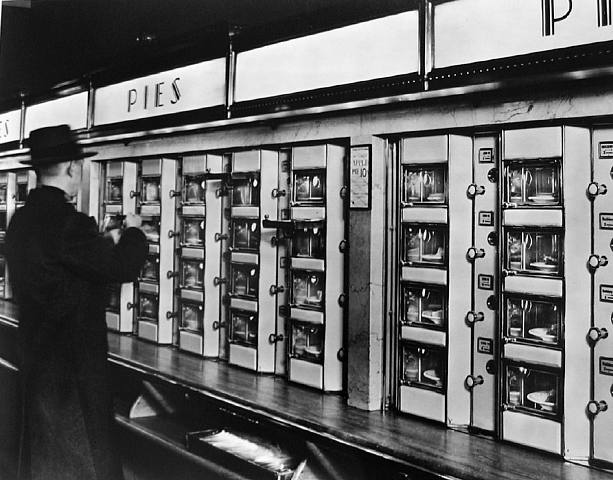Automats were once wildly popular coin-operated restaurants in NYC during that earlier age when it seemed retail and dining might be consumed by machines, but Weak AI wasn’t yet ready to deliver. Its time has arrived now, and as fast-food workers fight for living wages, machines that barely register in our consciousness prepare to operate with quiet efficiency. The opening of Aaron Gilbreath’s Harper’s blog post “Lunch at the Robot Grill“:
“This spring, at a time when American fast-food workers were marching to demand pay increases, and local governments were voting to raise the minimum wage, the Chili’s restaurant chain installed more than 45,000 tabletop touchscreen devices at 823 of its franchises nationwide. Customers at these locations can now order drinks and dessert directly through monitors, pay without the assistance of a server, play games, and read the digital edition of USA Today. The company has also installed computerized ovens at 1,200 locations. Applebee’s, meanwhile, has announced plans to follow suit with approximately 100,000 tabletop tablets by the end of 2014, while Panera Bread is replacing many registers with self-serve kiosks and adding technology that will allow customers to sit down, enter their orders and table numbers on a smartphone, and have their food delivered to them.
For consumers, such automation is convenient. For restaurant workers, it raises fears of displacement. Some analysts believe fast-food chains will respond to the push for higher wages by simply replacing servers and cooks with robots — some of which are already arriving: MIT’s Makr Shakr is capable of mixing cocktails ordered through mobile devices, while the Chinese-made NoodleBot cuts fresh noodles at a fraction of the usual cost. And a hamburger maker marketed by Momentum Machines can grind meat, cook patties, slice tomatoes, and assemble and bag approximately 360 burgers per hour. Restaurants around the world are exploring new ways to implement these new technologies. Since 2008, customers at Bagger’s, in Nuremberg, Germany, for example, have been ordering from touch screens, then waiting for the cook to deliver their food by sliding a container down a set of winding metal tracks, in a theatrical touch.
Japanese restaurants embrace a more pragmatic form of mechanization. At the thriving donburi chain Matsuya, customers order and pay for meals at self-serve machines known alternately as shokkenki or kenbaiki (both of which translate to ‘ticket machine’). So too at the home-style restaurant chain Yayoiken and at the countless independent curry, ramen, takoyaki, and udon restaurants that fill Japan’s bustling train stations and side streets. For these businesses and their customers, shokkenki are a benign convenience, so integrated into daily life that locals barely notice them.”
Tags: Aaron Gilbreath

